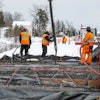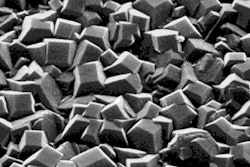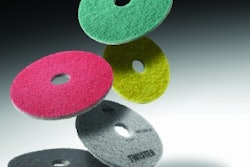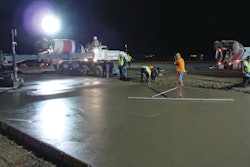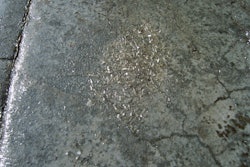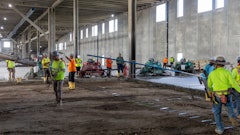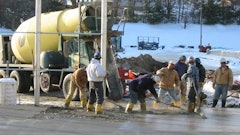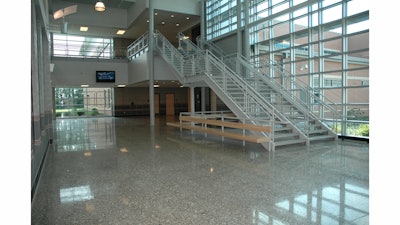
Polished concrete is manufactured on site. While other flooring is manufactured in a factory, the result is a product with consistency and known characteristics such as durability, wear ability, stain resistance, etc. So, how is polished concrete “manufactured” on site where there are tight time constraints and multiple trades in the same area while the manufacturing process is taking place? What can’t be addressed in specification’s that is needed for a successful installation?
Currently the most widely used and accepted specification used by specifiers is by the Concrete Polishing Association of America (CPAA). The CPAA specification should be used to fill in the specification sections not talked about in this article.
Polished concrete can be broken down into the manufacturing of the substrate to be polished and the processes used to polish the substrate. What factors need to be considered and controlled?
Producing the substrate to be polished
Any substrate can be put through a process of polishing but the substrate must be conducive to the polishing processes. Manufacturing of the substrate is as critical as the process used to manufacture the polished finish.
The following points are considerations required to produce a substrate that is easy to place and finish. Proper placement and finishing reduces the chance of delamination and shrinkage to reduce cracking, curling and produces tight consolidation and maximum durability enhanced by the mechanical polishing process. Many of these considerations are dependent on the geographical location and available materials needed to produce the substrate.
(Note: For additional considerations to be placed in the Division 3 specification, refer to the CPAA recommendations on their web site.)
- Sub surface requirements – slab on grade and deck
a. Preparation of the sub grade (reduces cracking)
b. Vapor barrier (type ASTM E1745 – 09, installation ASTM E1643 – 09)
c. Reinforcement
d. Bulkheads
e. Forms that create aesthetically pleasing construction joints and proper edge finishing
f. Penetration finishing that creates an aesthetically pleasing finish picture 1 - Concrete
a. Raw materials – cement (ASTM C150 – 09), water, aggregates (quality and properly gradated sand and course aggregates) Raw materials must be from the same batch and source to avoid variations in color.
b. Admixtures – plasticizers, retarders, accelerators can cause random variations in set times resulting in inconsistencies when finishing. Air entraining is not recommended by ACI for interior hard troweled surfaces and can cause micro voids in the polished finish. When admixtures are “not understood” by finishers delamination and other problems can occur.
c. Supplementary materials – fly ash, slag, fume – the total volume should not exceed 20 percent of cement volume and if possible avoid.
d. Integral color – also considered an admixture. If used, the cement fine layer needs to be removed, exposing sand aggregate to reveal the true color. Troweling and surface consolidation create different shades of color.
e. Mix design – the combination of raw materials and supplementary materials. The concrete mix design must be one that allows for ideal finishability.
f. Batching and Mixing – to maintain consistency of the substrate being manufactured. - Placement of slab body, edges, penetrations and pour backs
a. Craftsmanship of the finisher and experience
b. Placing – perform smaller pours to prevent concrete from getting away from finishers and allow attention to detail
c. Consolidation –ensures a substrate with a tight structure around aggregates
d. Surface finishing – effects reflective clarity, color and durability of the polished surface. To be performed by knowledgeable finishers to avoid delamination, spalling, over watering of the surface and washing out of cement fines around penetrations and edges. Tight consolidation of the surface around penetrations and edges should also be performed.
e. Flatness – The greater the Floor Flatness (FF) the less wavy the polish will look. See Picture 2
f. Construction and control joint placement means, methods, material and spacing to achieve aesthetically pleasing joints. I have pictures if needed. – yes please - Curing – To prevent the effects of moisture loss to avoid shadowing created by uneven hydration, surface crazing, delamination and cracking.
a. Water
b. Compound
c. Environmental conditions
(Note: The structural plans used by the cast-in-place contractor should include a graphic delineation showing the limits of the polished concrete to add emphasis to the placing/finishing contractor to pay extra attention to the polished concrete requirements during bidding and construction.)
The cast-in-place and polishing specification need to refer to one another by listing each in the RELATED SECTION of each specification.
Substrate Protection
- Protection before polishing
a. Stain prevention – Diaper all equipment. No pipe cutting. Temporarily protect the surface during steel erection, masonry, drywall and painting operations.
b. Construction traffic - No parking of vehicles or lifts, use non-marking tires.
c. Construction material staging on slab – Do not store materials on slab.
d. Hydration shadowing/moisture retention – Other than the proper means for curing do not cover the slab with any protection that traps moisture until all unused moisture required for hydration has left the slab to avoid shadowing caused by uneven hydration. Protection must be removed at the end of every day. No protection should be used in any manner for 28 days. Do not allow moisture to get trapped under protection when used after 28 days.
Producing the polished finish
The second component in manufacturing a polished concrete floor is producing the polish. The CPAA has defined three methods for producing a polished surface – Bonded Abrasive, Burnished and Hybrid Polished Concrete. Although not considered polished by the CPAA, Surface Coated Concrete does create a shiny surface. Each of these has its advantages, disadvantage and place in the industry.
(Note: Refer to the CPAA position papers in the specification section of the CPAA web site for a full understanding of each category.)
Bonded Abrasive Polished Concrete, as defined by the CPAA is the most specified type of polished concrete and is what the polished concrete industry is originally based on.
Concrete polishing specifications must be a balance between prescriptive and performance characteristics.
A prescriptive specification details step-by-step how the polished finish is to be produced. Unless the concrete substrate is reproduced exactly from one job to the next (polished with the same make and model of equipment; the equipment is moved across the surface at the same speed with the same rotational speed of the abrasives; the same weight of the equipment; the same diamond abrasives; the same number of abrasives used under the equipment, etc. is specified) a prescriptive specification will not work on every job. Prescriptive specifications do as much harm to the industry as shoddy workmanship. Each job is different based on the substrate, job site conditions and logistical requirements. Contractors who polish concrete own equipment from different manufacturers with different characteristics and purchase abrasives that also have different characteristics and quality. The polishing process has to be performed taking into many variables which will be different on each job.
A performance specification says it doesn’t matter how you produce the finished result as long as you meet specified measurable results. This is also a dangerous proposition for the industry since contractors often learn how to trick the means for measuring the surface finish.
When a combination of prescriptive and performance specifications are used you are able to specify more clearly what measurable finish is expected and the means required to produce the finish.
Getting back to basics
Over the last 15 years there has only been one “system” that repeatedly and consistently produces a surface with clarity of reflection, depth and durability. The following prescriptive steps will provide the best results the substrate will allow. The prescriptive factors are simple but effective.
The prescriptive factors
- Use bonded abrasives from X manufacturer that have a history of producing the best results the substrate will allow. It is not the densifier that creates the polish, it is the mechanical interaction between the abrasives and substrate. Why would a specific densifier be specified and required in the submittal process but not abrasives?
- Follow a sequence that follows a traditional sequential grit process, which does not skip grits and drops back one grit size when transitioning from metal bond abrasive to resin. If an abrasive manufacturers’ predetermined process is known to produce the same finish when compared to a traditional processes it would be acceptable.
Yes, I know, “The industry has progressed and there are transitional abrasives.”
“If transitional abrasives are used, comparison testing in several areas of the slab must be performed to determine if the transitional abrasives are providing the same if not better results than if you drop back one grit size when progressing from metal to resin bond abrasives.” This is where the performance side of the specification takes over. If a contractor can meet the performance requirements “through the use of bonded diamond abrasives” then it is at the discretion of the contractor on how they meet those requirements. Would it surprise you to know there was a time when a 600 grit was part of the process? Yes, the use of a 600 grit can make a significant difference.
3. Fully refine each abrasive to its maximum potential as defined by the CPAA.
4. Make sequential passes with each pass perpendicular to the previous pass.
5. Thoroughly clean the floor after each grit, removing debris larger than what the next grit size will produce.
6. Apply the densifier to the point of rejection and keep the surface saturated for 30 to 45 minutes. Apply the densifier based on porosity and environmental conditions. Re-apply to rejection and/or thin form later in the process as needed.
7. Apply semi impregnating microfilming or impregnating protection as defined by the CPAA.
8. Installer qualifications must be met as defined in the CPAA 03 3543 specification.
The specification must state the visual degree of cut (cream/cement fine, salt and pepper/sand aggregate or a degree of course aggregate) and the degree of polish (flat/ground, satin/honed, semi-polished or highly polished). (Note: The CPAA has a position paper that defines each of these in detail and the quantifying criteria for each.)
Other visual characteristics that need to be defined in the specification and finish plan are color, decorative cuts and joint fill. Protection after polishing should be a type that will withstand remaining construction to be performed after the floors have been polished. The polishing contractor should be required, prior to turn over to the owner, to return to perform a final clean and burnishing of the surface as well as maintenance training of the owners floor care staff.
Starting and finishing abrasive grits should not be specified to achieve the degree of cut (cream/cement fine, salt and pepper/sand aggregate and course aggregate) or finished gloss. The concrete, machine weight, rotational movement and speed, forward liner pace, abrasive type, bonding and contact area to the surface will determine starting and finishing grits. This is another facet of the process that can be met through the combination of a prescriptive and performance specification.
Why do polished concrete installations fail?
When manufacturing other flooring in a factory, all components are controlled by one company. When manufacturing a polished concrete floor on site there are often six or more independent companies involved in the manufacturing process and countless other companies working on top of and around the “onsite factory.” As a result, specifications and plans can only go so far to ensure a successful polished concrete installation.
Specifications start with the architect properly writing them. To do this, the architect must take the time to understand the total process which includes the manufacturing of the slab and polishing. Each project requires customized specifications, do not copy and paste. The qualification section must require confirmable past performance of jobs as the same size and scope. Submittals must then require the qualification information be submitted as part of the submittal package. There’s a disconnect in many specifications where qualifications of the subcontractor are stated but this information is not required in the submittals. When qualifications are listed to be submitted, rarely is the information asked for and when it is, rarely is it checked.
The use of specifications starts with the estimator and the estimator confirming and only taking bids from sub-contractors who meet the qualifications portion of the specification.
Specifications are only as good as the general contractor and sub-contractors relied upon to understand them and follow them.
Installations require increased and equal craftsmanship by all trades involved. One trade should not be expected to make up for the short comings of another trade.
The architect and owner must hold the general contractor accountable. Let me say it one more time, the architect and owner must hold the general contractor accountable. The general contractor must hold the sub-contractors accountable.
A polished concrete installation goes beyond specifications for there to be total success. Specifications alone will not result in a successful polished concrete installation.
It is the responsibility of the architect and owner to have a reasonable expectation of what a polished concrete floor is. They must understand the floor is being manufactured on site and when finished it will not be perfect, there will be imperfections inherent with all concrete, it will be consistently inconsistent. They need to understand variables during finishing such as wind, the angle of the sun, humidity, and temperature will affect the finished surface and most often this becomes too hard to control.
What an owner will get is a floor that can help achieve many LEED points, be aesthetically pleasing, highly durable and extremely low maintenance. A decision to use polished concrete should not be based on pretty pictures from the Internet or brochures, but based on site visits to other buildings like the one being constructed.
If a general contractor does not take the time to understand the process and commit to the process, the polished concrete project will be a failure. The general contractor is responsible for coordinating all trades involved in making the polished concrete project a success. They are the ones who have to ensure specifications are followed and the requirements of the specifications are met. Not only do they need to understand the processes, they need to understand the jobsite and polished concrete contractor’s requirements for installation. Polished concrete is installed differently than other finishes. Polished concrete is installed during major construction and not at the end when other finishes are installed. It is also the general contractor’s responsibility to understand what the architect and owner’s expectation is. The general contractor is the one responsible for monitoring and qualifying the finished work. Too often does a general contractor not take the time to understand these expectations and the result is a polishing contractor having to deal with the general contractor’s expectation and opinions which are most often different from the architect and owner.
General contractors and sub-contractors need to know while they are bidding the project there is extra coordination required between multiple trades and companies in the manufacturing of the final floor finish that will happen during major construction. For some of the other trades this will mean nothing more than they will be required to place and remove protection daily and extra trade coordination will be required that can effect progression through the project.
The cast-in-place and polishing subcontractors need to know there will be extra focus and emphasis required to make sure specifications are met. Often to ensure quality, pours need to be made on a smaller scale and extra workers are required to ensure detailed quality. Extra time will be required by the general contractor to monitor the other trades on site to ensure they do not damage the concrete to be polished. Polished concrete requires large areas to be free and clear of all materials and trades when polished. The process is slow and produces a lot of mess. This is not all of the considerations but some of the many a general contractor needs to be aware of. If they are not aware of the requirements, they often do not learn about them until after schedules have been made. (See side bar)
General contractors don’t like unexpected surprises. Often the requirements for the polished concrete manufacturing processes are not realized until after the polishing has been awarded to a concrete polisher and pre pour meetings take place. The result is a general contractor project team who become unwilling to rearrange schedules, take the time to fully grasp the polished concrete installation and its total requirements. The result is a failed polished concrete installation.
To ensure the general contractor embraces the success of the polished concrete installation they must be made aware of the requirements that are means and methods related and not put into specifications. The best way to do this is in the summary section of Division 1. Fully make the general contractor, cast-in-place, polishing contractor and all other trades aware of the emphasis that will be placed on the polished concrete finish. Let them know now is the time to fully understand the specifications, the architect’s expectations, time requirements and other considerations required for a successful installation. The general contractor and sub-contractors must understand the cast-in place and polishing specification will be held and any deficiencies will become a liability to them. All other trades must be alerted of the additional requirements that maybe placed on them during the manufacturing processes and specifically what they can and cannot do over the substrate to be polished.
A polished concrete installation requires realistic expectations, understanding of the process, held specifications of all trades and an effort on the part of everyone involved for success. For the polished concrete project to be successful both the concrete placer/finisher and polisher must perform their scope with craftsmanship. A successful installation is a group effort and goes beyond specifications. The result is a floor that can help achieve many LEED points, aesthetically pleasing, highly durable and extremely low maintenance.
For a copy of the CPAA specification visit their web site- www.concretepolishingassociation.com


